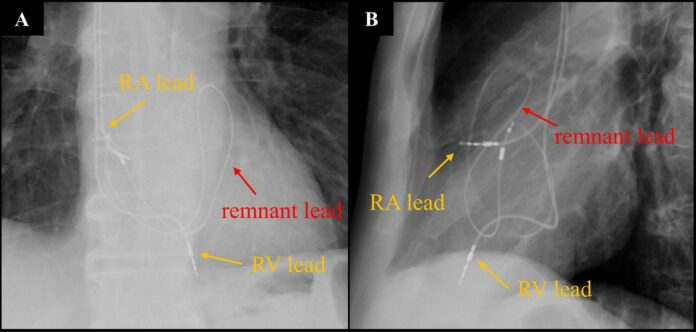
Remnant floating pacemaker lead in 72-year-old
The incidence of dislodged pacemakers is reported to be less than 1% in literature. However, lead fracture is a common complication in cardiac implant devices with more cases reported in physically active individuals. It often occurs as a result of compression of the lead between the first rib and clavicle, just lateral to the subclavian venous entry site. This article describes the case of a physically active patient whose pacemaker dislodged while playing tennis, because of an excessive movement of the upper limbs. Fortunately the patient got lucky and the ventricular lead did not break, had it been the case, the likeliness of collapsing would have increased.
A remnant lead of the patient’s pacemaker migrated to the right side of the heart while playing tennis
The remnant lead can migrate to the right side of the heart or pulmonary artery, leading to more serious complications and symptoms. Therefore, it is recommended that patients with pacemakers are evaluated frequently with the help of X-rays. The 72-year-old patient underwent a dual-chamber pacemaker implantation 11 years ago. He was a frequent swimmer and actively played table tennis. Although 3 years ago the patient complained symptoms of shortness of breath while playing tennis. An X-ray was performed 3 months later which showed a complete disconnection and fracture of the lead. However, despite the fracture, the patient continued to swim and play tennis.
3 years later another atrial lead dysfunction occurred
3 years later another atrial lead dysfunction was suspected at his routine pacemaker evaluation. What’s more, the distal part of the lead was seen floating in the right atrium and ventricle. Although the patient was asymptomatic, there were signs of frequent non-sustained ventricular tachycardia noted. His case was referred to a cardiovascular surgeon who performed a percutaneous extraction of the floating leads. The leads were extracted successfully without any complications, eliminating the risk of arrhythmias. Doctors advised the patient to discontinue table tennis and swimming activities but he continued to do so after being discharged.
No lead incidents were reported for a year.
References
Successful percutaneous extraction of a remnant floating pacemaker lead https://casereports.bmj.com/content/14/5/e243128



